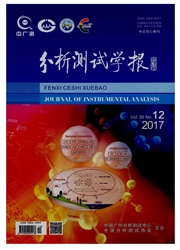

 中文摘要:
中文摘要:
采用循环伏安法和差分脉冲伏安法对水杨酸在电活化玻碳电极上的电化学行为进行研究。在pH7.0的PBS溶液中,将玻碳电极用恒电位法在+1.7V电位阳极氧化400s。在0.2mol·L^-1NaOH溶液中,水杨酸在0.602V处有一良好的氧化峰,其氧化峰电流与扫描速率在0.02~0.2V·s^-1范围内呈良好线性关系,表明电极过程为受吸附控制的不可逆过程。差分脉冲伏安法的氧化峰电流(Ipa)与水杨酸的浓度在5.0×10^-6—2.0×10^-3mol·L^-1范围内呈良好的线性关系,相关系数为0.9863,检出限为1.2×10^-7mol·L^-1,该方法操作简便,重复性较好,将其用于阿司匹林片剂中水杨酸含量的检测,结果满意。
 英文摘要:
英文摘要:
The electrochemical behavior of salicylic acid (SA) on an electro-activated glassy carbon electrode (EGCE) was studied by cyclic voltammetry(CV) and differential pulse vohammetry (DPV). The glassy carbon electrode ( GCE ) was activated in pH 7.0 PBS buffer for 400 s by poteutiostatic method at + 1.7 V. In 0.2 mol · L^-1 NaOH solution, a well-defined oxidative peak of SA was observed at 0. 602 V (vs. Ag/AgCl) on the activated electrode. The anodic peak current increased linearly with scan rate from 0. 02 V · s^- 1 to 0.2 V · s^- 1, revealing that the reaction was a absorptioncontrolled process. The experimental parameters were optimized and the correlation between peak current (Ipa) and concentration was studied by differential pulse vohammetry. Under the optimal conditions, the linear range for SA was in the range of 5.0 × 10^-6 - 2.0 × 10^ -3 mol · L^-1 with a correlation coefficient of 0. 986 3, and the detection limit(S/N =3) was 1.2 × 10^-7 mol · L^-1 The activated glassy carbon electrode showed the advantages of simple preparation procedure and good reproducibility, and was applied in the determination of salicylic acid in pharmaceutical drugs with satisfactmy results.
 同期刊论文项目
同期刊论文项目
 同项目期刊论文
同项目期刊论文
 期刊信息
期刊信息
